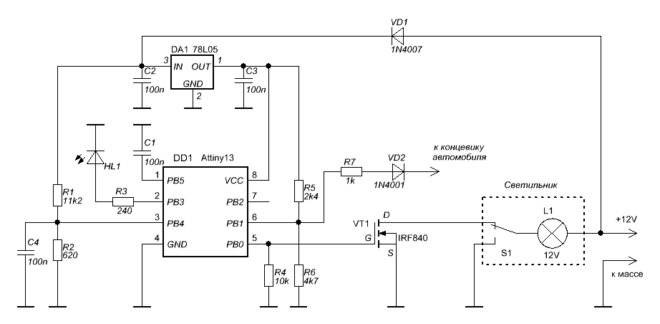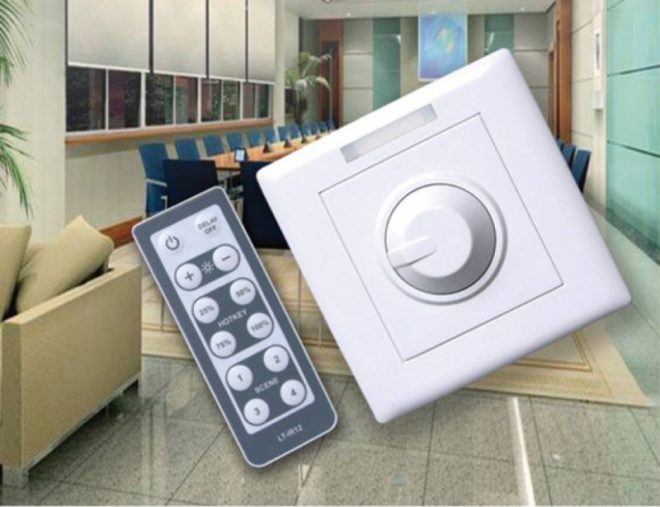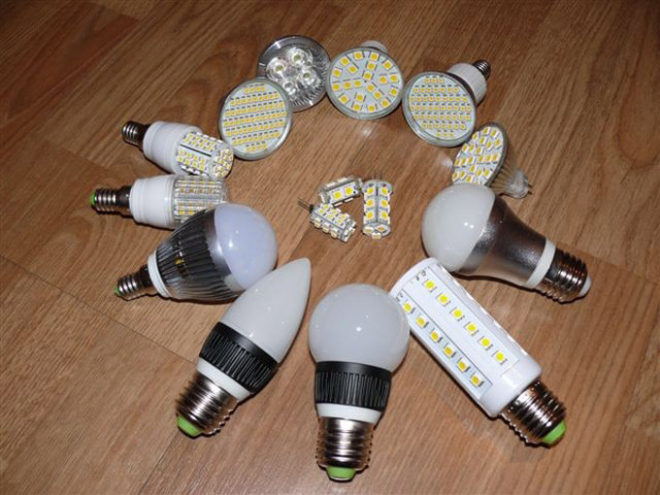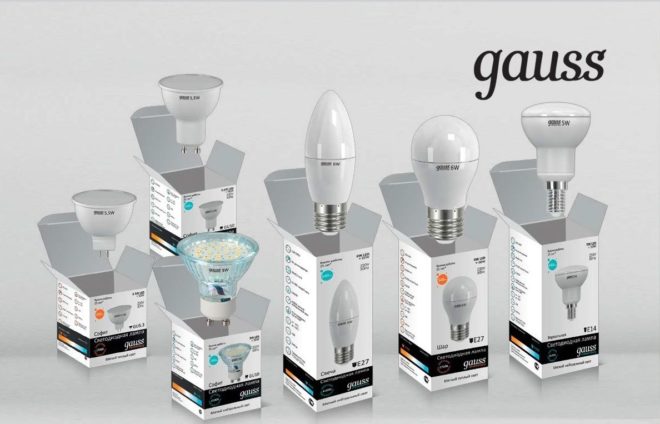Dimming of LED lamps 220 volts
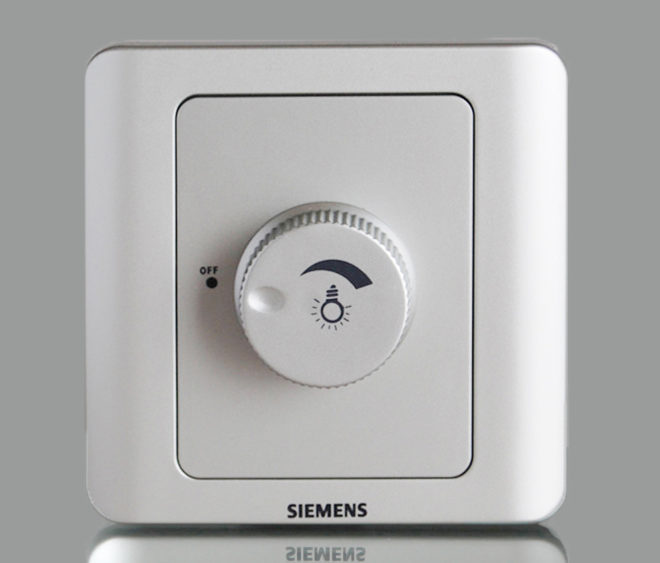
Recently, among the elements of the household electrical network, a dimmer for 220 V LED lamps is gaining rapid and widespread popularity and this is quite logical, because with the help of such devices the functions of LED lighting sources are expanded.
The installed dimmer makes it possible not only to adjust the power and brightness of the light, but also to set the color shades of the LEDs and the order of switching on / off the lamps (by timer) using a special program. Moreover, all this can be done even remotely, by controlling the remote control from anywhere in the room, or even from other rooms using Wi-Fi from a phone or tablet.
Content
Application area
Someone may have a question, why do you need to adjust the brightness of the lighting at all? First of all, for a comfortable light environment at home. In the evening you sit in the living room or living room, relax and at this moment you do not need bright lighting at all. A dimmer for lamps allows you to turn them on at 10-30% of the power from the nominal value. When you need a lot of light, you just need to use the regulator to turn on the lamps at their full power.

Dimmers are used both in residential premises and in public places. These devices are especially convenient when there is a need for emergency lighting. In shops, pharmacies, banks, office premises, light is often left in the halls and foyers at night so that the bulbs do not work at full power, they use dimmers. In addition to all this, it gives a good economic effect in terms of energy consumption.
Now the “smart home” system is gaining more and more popularity, when many household appliances (air conditioner, fan, TV), as well as electric heating or lighting are controlled using signals. In this case, one cannot do without dimmers, although by and large the “smart home” system is still a luxury, not a necessity.
Benefits

The dimmer used for LED lamps has several positive aspects:
- With its help, you can save energy.
- By controlling the brightness of the lighting, in the rooms you can emphasize the most advantageous areas and places (panels on the wall, floor composition, etc.), which improves the design of the entire interior.
- The load can be changed smoothly.
- The most important advantage is the comfort of the light mode at any time of the night or day.
- Increasingly, a dimmer for LED luminaires is used as a watchdog. You can set a special program with which the lamps will be switched on and off at different times in separate rooms. This will create the illusion that someone is present at home. It is very convenient to protect your households from intruders in this way if you need to leave for a few days. All this is possible due to the fact that dimmers are able to support dimming and blinking modes.
- Such a regulator will serve as overvoltage protection in the network.
- Since with the help of the regulator, the electrical resource of the lamp is saved, this contributes to the extension of its service life.
You see how many good and useful functions such a device performs. So, despite the complexity of the connection diagram, the high cost, the need to rewire the already existing wiring elements, it is still worth spending money on the dimmer.
Device and principle of operation
A dimmer for LED lamps is very similar in design and function to a device designed for other light sources.
In fact, a dimmer is a switch that only has many functions, the main of which is to control the intensity of the light flux. Previously, they were purely mechanical and were only used to change the brightness of light. Now, already in the design of the dimmer, microcontrollers (microcircuits) are necessarily present, with the help of which it performs many functions.
The dimmer device is based on the principle of the rheostat. By changing the resistance, the voltage applied to the bulb changes. Also, the regulator necessarily has a set of resistors (triacs), due to which the light intensity changes.
Model selection
By the way of control, dimmers can be classified into:
- Sensory. The device has a touch panel, by direct contact with it, the dimmer is controlled. Their main difference from other models is their stylish design, especially suitable for those who have a high-tech interior. Another undeniable advantage of touch dimmers is ease of control.
- Remote. The control takes place at the expense of a remote control or a wireless channel. Especially suitable for those who do not release a smartphone or tablet out of their hands in everyday life, with the help of these gadgets you can control home lighting from a distance.
- Mechanical. Lighting is controlled by acting on a key or a rotary dimmer knob. Differs in sufficient reliability in use and low cost.
- Acoustic. The adjustment is carried out due to the response to clap, sound, noise, voice command. Many people call this model pretentious. Such a dimmer is expensive. It is bought mainly by those who have enough extra money and who really want to surprise others.
Of course, when choosing a regulator, consider your financial capabilities, but try to avoid cheap Chinese products. In the market of electrical goods, dimmers from such manufacturers have proven themselves in an excellent way:
- Schneider Electric;
- Lezard;
- ABB.
LED lamp
Before talking about how LED lamps are combined in their work with a dimmer, let's at least superficially understand what the features of such a light source are, how it works, can it be used in living quarters?
It is now customary to say about LED lamps that this is a new generation of a light source. They are a complete replacement for compact fluorescent lamps and traditional incandescent lamps in luminaires. Such a light bulb has an indisputable advantage, it saves energy and money consumption many times over. Judge for yourself, the power of a 7 W LED lamp is equivalent to the power of a 60 W incandescent lamp. In addition, in many LED lamps, the light intensity can be adjusted using a dimmer (in other words, these lamps are called dimmable).
The main light-forming element in such lamps are LEDs. There may be a different number of them, depending on this, the total power of the light bulb changes. They are hidden under an opaque body, which makes LED lamps fundamentally different from transparent incandescent lamps.
The entire constructive device of an LED lamp includes the following elements:
- Plinth. Made of brass, nickel plated, it ensures reliable contact between the lamp and the lamp holder.
- The plinth has a polymer base, which protects the housing from electric shock.
- A driver is mounted on a polymer base, which ensures stable operation of the lamp during voltage drops.
- Next comes the radiator, which ensures efficient heat removal from the lamp elements.
- A printed circuit board with LEDs is securely attached to the radiator.
- And the last element is a hemispherical light diffuser.
Dimmer Lamp Compatibility
Surely you have heard that you cannot install a dimmer in a circuit for LED and energy-saving lamps of 220 V. Previously, this opinion was relevant, indeed, only incandescent lamps could be connected through the regulator. But now there are already special LED DIM lamps, which do not require any separate dimmers. They can be triggered via a conventional incandescent dimmer. Moreover, LED DIM bulbs can be installed in the same circuit as incandescent bulbs.
If you already have LED lamps installed, then before purchasing a regulator, figure out how they can be compatible in the same electrical circuit.
LED bulbs can be:
- Unregulated. You cannot put them in the same circuit with a dimmer, otherwise this will lead to malfunctions of the lamp and in the future to its combustion.
- Adjustable. They can be combined with dimmers operating on the principle of cutting off the fronts of a sine wave voltage. The only caveat is that the main work of the dimmer begins with a minimum load of 20 to 45 W. To achieve such a load, one incandescent lamp will be enough, but 3-4 LEDs will be required. In the case when there is only one lamp in the lighting device, a low voltage regulator with a magnetic transformer can be used.
- With a special regulator. Many manufacturers produce LED bulbs that require a separate dimmer.
In electrical stores, sales consultants have special tables, which can be used to find out how compatible LED lamps are with certain types of regulators.
When purchasing such lamps, pay attention to the original packaging or consult your dealer if it can be dimmed. Manufacturers display this possibility with special inscriptions or round icons on the packaging.
In the market of electrical goods, Gauss dimmable LED lamps, operating from a voltage of 220 V.
As you can see, the dimmer used in the home electrical network is very convenient for human comfort and beneficial from an economic point of view. And combining it with 220 V LED lamps enhances these effects several times. We can say that this is exactly the case when "the game is worth the candle."

